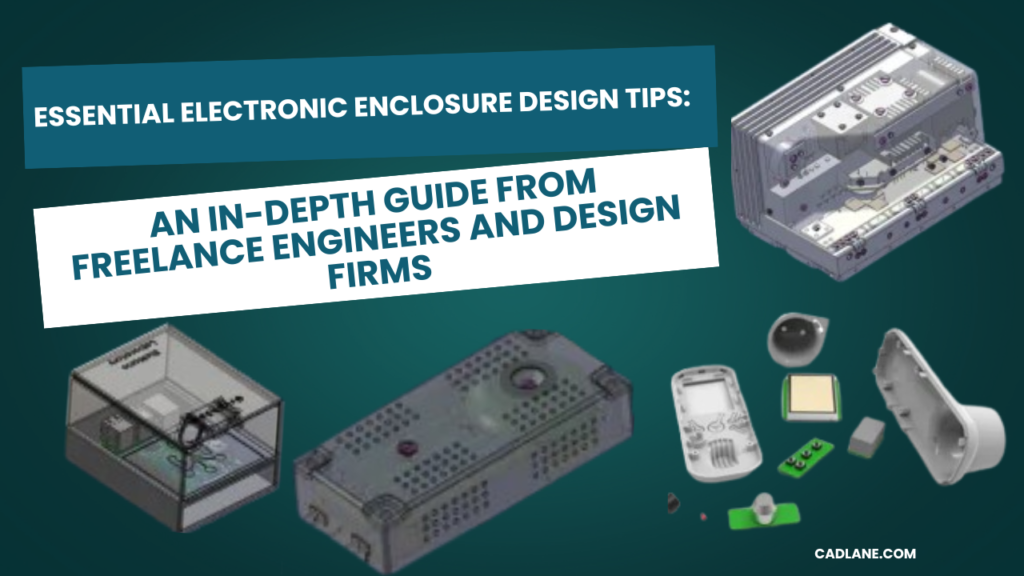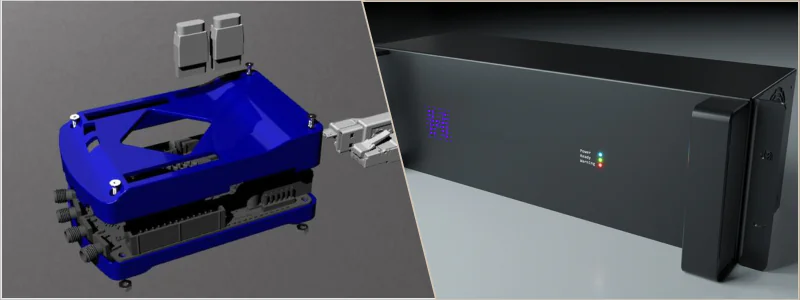
One of the most important, although often overlooked, areas of design in the development process for electronic devices, machines, and systems is the designing of enclosures. While enclosures protect sensitive components from environmental influences, physical-mechanical damage, and EMI, these must provide pleasant exteriors and easy-to-use interfaces to the user. Well-designed enclosures are mandatory for all industries of medical equipment, consumer electronics design services, testing equipment, and more.
This blog outlines some electronic enclosure design tips from freelance engineers and firms offering design services. The selection of materials, thermal management, user accessibility, and regulatory compliance are also included. All fundamental topics can be discussed in length to establish a thorough insight into electronic enclosure designs.
Table of Contents
- What is an electronic enclosure?
- Small electronic enclosures
- Large electronic enclosures
- Importance of electronic enclosure design
- Basic steps of electronic enclosure design
- Step 1: Describe the application
- Material selection
- Size and enclosure dimensions
- Cooling and thermal management
- Ventilation and airflow
- Enclosure accessories
- Protection ratings (NEMA, IP)
- Mounting options
- Enclosure finish
- Considerations when designing electronic enclosures
- Cost management
- Ease of use
- EMI/RFI Shielding
- Environmental protection
- Ergonomics and aesthetics
- Compliance with regulations
- Size and form factor
- Thermal management
- Modularity and accessibility
- Testing and documentation
- In conclusion
- How Cadlane can help
What is an Electronic Enclosure?
An electronic enclosure is a casing used to house electrical or electronic components. The size, materials, and complexity can vary widely according to the specific needs of the equipment. It ranges from small handheld devices to large industrial cabinets.
Small Electronic Enclosures
Small electronic enclosures are commonly used for key fobs, USB drives, and devices mounted on DIN rails. They are often designed for low-voltage applications where cooling and environmental protection are not primary concerns but still provide essential protection from dust, minor impacts, and general wear.
Large Electronic Enclosures
Large electronic enclosures, such as wall-mounted cabinets and free-standing units, are used in industries like telecommunications and manufacturing. These enclosures often need to withstand severe environmental conditions, including heat, moisture, dust, and mechanical impacts. Outdoor enclosures must also be resistant to rain, snow, and salt spray.
Importance of Electronic Enclosure Design
Well-designed enclosures are crucial for protecting sensitive components and ensuring optimal performance. Enclosures safeguard electronics from environmental hazards like moisture, dust, and electromagnetic interference while also aiding in heat dissipation. Industries such as telecommunications, automotive, and consumer electronics rely on durable, safety-focused enclosures to enhance product longevity and reliability.
Basic Steps of Electronic Enclosure Design
Step 1: Describe the Application
Understanding the purpose of the enclosure influences its size, shape, materials, and features. Both external and internal factors should be carefully assessed to ensure proper component protection.
- External Factors:
- Temperature and humidity impact material choice and cooling methods.
- Weather conditions such as rain and UV exposure affect outdoor enclosures.
- Dust and particles can interfere with industrial enclosures if not properly sealed.
- Internal Factors:
- Vibration and shock resistance are critical for preventing damage.
- Heat buildup should be managed with proper ventilation and thermal dissipation.
Material Selection
Choosing the right material determines an enclosure’s durability, cost, and performance:
- Aluminum: Lightweight and heat-resistant but susceptible to corrosion.
- Fiberglass: Resistant to chemicals and extreme environments but has lower thermal conductivity.
- Plastic: Cost-effective but less durable than metals.
- Steel (stainless or carbon): Durable and robust, with stainless steel offering corrosion resistance.
Size and Enclosure Dimensions
Balancing size, functionality, and cost is essential. Oversized enclosures waste space and resources, while undersized designs may not accommodate necessary components. Adequate room for future upgrades and maintenance access is crucial.
Cooling and Thermal Management
Heat management strategies include:
- Natural or forced airflow: Ventilation and fans help dissipate heat.
- Air conditioners: Used when ventilation alone is insufficient.
- Heat sinks: Passive cooling devices to prevent overheating.
Ventilation and Airflow
Proper airflow prevents hotspots and gas accumulation, reducing explosion risks in hazardous environments.
Enclosure Accessories
Enhance enclosure functionality with:
- Ventilation fans for improved cooling
- Cable glands to protect wiring
- Locks and latches for security
- Hinges for easy access
- Mounting brackets for stable installation
Protection Ratings (NEMA, IP)
Protection ratings define an enclosure’s resistance to environmental elements. Consider operating conditions and necessary protection against moisture, dust, and impact.
Mounting Options
Enclosures can be wall-mounted, pole-mounted, pad-mounted, floor-mounted, or free-standing, depending on application requirements.
Enclosure Finish
Finishing methods impact aesthetics and durability:
- Painting: Cost-effective but requires frequent touch-ups.
- Powder coating: More durable and resistant to wear.
- Anodizing: Used for aluminum enclosures to enhance corrosion resistance.
Read about best selling Autodesk AutoCad 2025 to empower your designs.
Considerations When Designing Electronic Enclosures
Cost Management
Optimize cost without sacrificing quality by using off-the-shelf components and efficient manufacturing processes.
Ease of Use
User-friendly designs ensure easy access to controls and interfaces, especially in consumer and medical devices.
EMI/RFI Shielding
Use conductive materials or coatings to protect sensitive electronics from electromagnetic interference.

Environmental Protection
Select materials resistant to moisture, chemicals, and weather conditions, particularly for outdoor enclosures.
Ergonomics and Aesthetics
Well-designed enclosures improve usability and brand identity, particularly in consumer and medical products.
Compliance with Regulations
Ensure adherence to industry-specific standards, safety certifications (UL, CE), and design features like tamper-evident seals.
Size and Form Factor
Optimize the balance between functionality, space efficiency, and ease of installation.
Thermal Management
Incorporate heat dissipation methods such as integrated heat sinks and ventilation.
Modularity and Accessibility
A modular design simplifies upgrades and maintenance, improving long-term usability.
Testing and Documentation
Comprehensive testing ensures compliance with performance standards, while proper documentation supports future reference and production.
Conclusion
Designing an electronic enclosure involves multiple considerations, from environmental protection and material selection to thermal management and usability. Thoughtful design enhances product performance, longevity, and user experience. Engineers must integrate enclosure planning early in the development process to ensure success.
How CadLane Can Help
Need expert enclosure design services? CadLane connects you with top freelance engineers and design firms to develop custom electronic enclosures tailored to your needs. Get a quote today!
